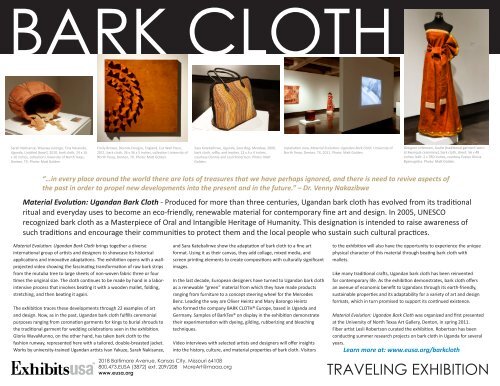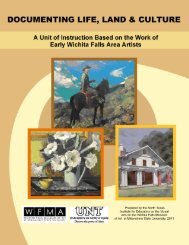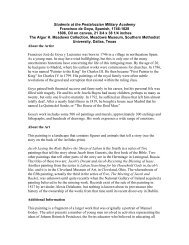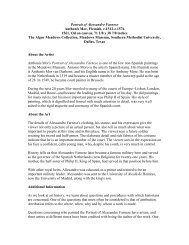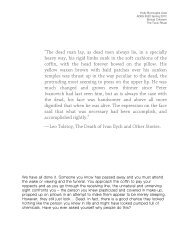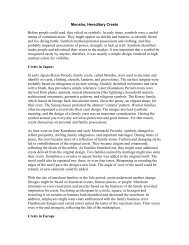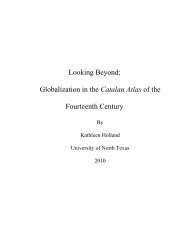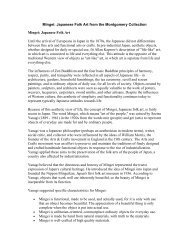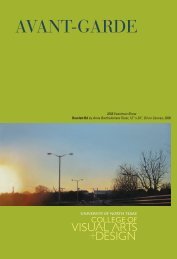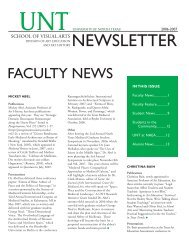Here - University of North Texas
Here - University of North Texas
Here - University of North Texas
Create successful ePaper yourself
Turn your PDF publications into a flip-book with our unique Google optimized e-Paper software.
BARK CLOTH<br />
Sarah Nakisanze, Wasswa Lulongo, Tina Nassinde,<br />
Uganda, Untitled [bowl], 2010, bark cloth, 24 x 16<br />
x 16 inches, collection <strong>University</strong> <strong>of</strong> <strong>North</strong> <strong>Texas</strong>,<br />
Denton, TX. Photo: Matt Golden.<br />
Emily Brewer, Decode Designs, England, Cut Wall Piece,<br />
2011, bark cloth, 36 x 36 x 5 inches, collection <strong>University</strong> <strong>of</strong><br />
<strong>North</strong> <strong>Texas</strong>, Denton, TX. Photo: Matt Golden.<br />
Sara Kateballirwe, Uganda, Sara Bag, Meadow, 2009,<br />
bark cloth, raffia, and leather, 12 x 4 x 4 inches,<br />
courtesy Donnie and Lesli Robertson. Photo: Matt<br />
Golden.<br />
Installation view, Material Evolution: Ugandan Bark Cloth, <strong>University</strong> <strong>of</strong><br />
<strong>North</strong> <strong>Texas</strong>, Denton, TX, 2011. Photo: Matt Golden.<br />
Designer Unknown, Suuka [traditional garment worn<br />
at Kwanjula ceremony], bark cloth, sheet: 56 x 48<br />
inches; belt: 2 x TBD inches, courtesy Evelyn Gloria<br />
Byamugisha. Photo: Matt Golden.<br />
“…in every place around the world there are lots <strong>of</strong> treasures that we have perhaps ignored, and there is need to revive aspects <strong>of</strong><br />
the past in order to propel new developments into the present and in the future.” – Dr. Venny Nakazibwe<br />
Material Evolution: Ugandan Bark Cloth - Produced for more than three centuries, Ugandan bark cloth has evolved from its traditional<br />
ritual and everyday uses to become an eco-friendly, renewable material for contemporary fine art and design. In 2005, UNESCO<br />
recognized bark cloth as a Masterpiece <strong>of</strong> Oral and Intangible Heritage <strong>of</strong> Humanity. This designation is intended to raise awareness <strong>of</strong><br />
such traditions and encourage their communities to protect them and the local people who sustain such cultural practices.<br />
Material Evolution: Ugandan Bark Cloth brings together a diverse<br />
international group <strong>of</strong> artists and designers to showcase its historical<br />
applications and innovative adaptations. The exhibition opens with a wallprojected<br />
video showing the fascinating transformation <strong>of</strong> raw bark strips<br />
from the mutuba tree to large sheets <strong>of</strong> non-woven fabric three or four<br />
times the original size. The cloth continues to be made by hand in a laborintensive<br />
process that involves beating it with a wooden mallet, folding,<br />
stretching, and then beating it again.<br />
The exhibition traces these developments through 22 examples <strong>of</strong> art<br />
and design. Now, as in the past, Ugandan bark cloth fulfills ceremonial<br />
purposes ranging from coronation garments for kings to burial shrouds to<br />
the traditional garment for wedding celebrations seen in the exhibition.<br />
Gloria WavaMunno, on the other hand, has taken bark cloth to the<br />
fashion runway, represented here with a tailored, double-breasted jacket.<br />
Works by university-trained Ugandan artists Ivan Yakuze, Sarah Nakisanze,<br />
2018 Baltimore Avenue, Kansas City, Missouri 64108<br />
800.473.EUSA (3872) ext. 209/208 MoreArt@maaa.org<br />
www.eusa.org<br />
and Sara Katebalirwe show the adaptation <strong>of</strong> bark cloth to a fine art<br />
format. Using it as their canvas, they add collage, mixed media, and<br />
screen printing elements to create compositions with culturally significant<br />
images.<br />
In the last decade, European designers have turned to Ugandan bark cloth<br />
as a renewable “green” material from which they have made products<br />
ranging from furniture to a concept steering wheel for the Mercedes<br />
Benz. Leading the way are Oliver Heintz and Mary Barongo Heintz<br />
who formed the company BARK CLOTH® Europe, based in Uganda and<br />
Germany. Samples <strong>of</strong> BarkTex® on display in the exhibition demonstrate<br />
their experimentation with dyeing, gilding, rubberizing and bleaching<br />
techniques.<br />
Video interviews with selected artists and designers will <strong>of</strong>fer insights<br />
into the history, culture, and material properties <strong>of</strong> bark cloth. Visitors<br />
to the exhibition will also have the opportunity to experience the unique<br />
physical character <strong>of</strong> this material through beating bark cloth with<br />
mallets.<br />
Like many traditional crafts, Ugandan bark cloth has been reinvented<br />
for contemporary life. As the exhibition demonstrates, bark cloth <strong>of</strong>fers<br />
an avenue <strong>of</strong> economic benefit to Ugandans through its earth-friendly,<br />
sustainable properties and its adaptability for a variety <strong>of</strong> art and design<br />
formats, which in turn promised to support its continued existence.<br />
Material Evolution: Ugandan Bark Cloth was organized and first presented<br />
at the <strong>University</strong> <strong>of</strong> <strong>North</strong> <strong>Texas</strong> Art Gallery, Denton, in spring 2011.<br />
Fiber artist Lesli Robertson curated the exhibition. Robertson has been<br />
conducting summer research projects on bark cloth in Uganda for several<br />
years.<br />
Learn more at: www.eusa.org/barkcloth<br />
TRAVELING EXHIBITION
Curator: Lesli Robertson, Artist and Senior Lecturer,<br />
<strong>University</strong> <strong>of</strong> <strong>North</strong> <strong>Texas</strong>, TX<br />
Organized by: Tracee W. Robertson, Director, <strong>University</strong><br />
<strong>of</strong> <strong>North</strong> <strong>Texas</strong>, Denton, TX<br />
Content: 23 contemporary works in bark cloth by<br />
African, European, and American artists and designers<br />
Duration: 7-week display<br />
Rental Fee: Moderate<br />
In-Region Rental Fee: Low<br />
Shipping expense: Exhibitor is responsible for payment<br />
<strong>of</strong> outgoing fine art shipping.<br />
Programming Grant: Venues in Arkansas, Missouri,<br />
Nebraska, Oklahoma, and <strong>Texas</strong> are eligible for a $1,000<br />
Public Programming Grant<br />
Security: Moderate D<br />
Run. ft.: 100<br />
Sq. Ft.: 50 (for objects only)<br />
Insurance: The exhibition is fully insured by ExhibitsUSA<br />
at no additional expense to you, both while installed and<br />
during transit.<br />
DATES AVAILABLE<br />
Material Evolution is scheduled to begin touring April<br />
2014 through March 2017. The dates below reflect<br />
7-week exhibition periods. Dates are subject to change;<br />
please contact MoreArt@maaa.org or (800) 473-3872<br />
x208 for current availability.<br />
Installation view, Material Evolution: Ugandan Bark Cloth, <strong>University</strong> <strong>of</strong> <strong>North</strong> <strong>Texas</strong>, Denton, TX, 2011. Photo: Matt Golden.<br />
April 6 - May 25<br />
June 2011 - May 2013<br />
June 16 - August 11<br />
September 1 - October 20<br />
November 10 - January 7<br />
January 28 - March 16<br />
THE EXHIBITION IN YOUR GALLERY<br />
ExhibitsUSA allows venues to customize the<br />
exhibition for your space. You may wish to enhance<br />
the exhibition content with additional objects from<br />
your collection or community resources. You may<br />
also wish to edit objects from the exhibition due<br />
to space restrictions or content. If your institution<br />
plans to augment or edit the exhibition you are<br />
hosting, please notify us <strong>of</strong> your changes so that we<br />
may better serve your needs.<br />
SUPPORT MATERIALS AND SERVICES<br />
When you host an EUSA exhibition, you will<br />
receive a range <strong>of</strong> support materials to present the<br />
exhibition to your community.<br />
THESE INCLUDE:<br />
• A publicity packet with digital images and<br />
logos, a sample press release, and public service<br />
announcement.<br />
• An educational programming guide with lesson<br />
plans for teachers, information for docents, and a<br />
bibliography <strong>of</strong> books, videotapes, CD-ROMs, and<br />
hands-on materials.<br />
• Interpretive labeling, written and designed by<br />
ExhibitsUSA, available in printable formats on disk.<br />
• Catalogues, brochures or reproducible gallery<br />
guides, and text panels.<br />
• A registrar’s packet with the final checklist,<br />
checklist receipt, packing list, and clear instructions<br />
for installing and de-installing the exhibition.<br />
• A condition report with detailed photographs and<br />
descriptions.<br />
• Custom-designed crates for easy handling and<br />
maximum protection, along with photographs and<br />
instructions for proper packing


